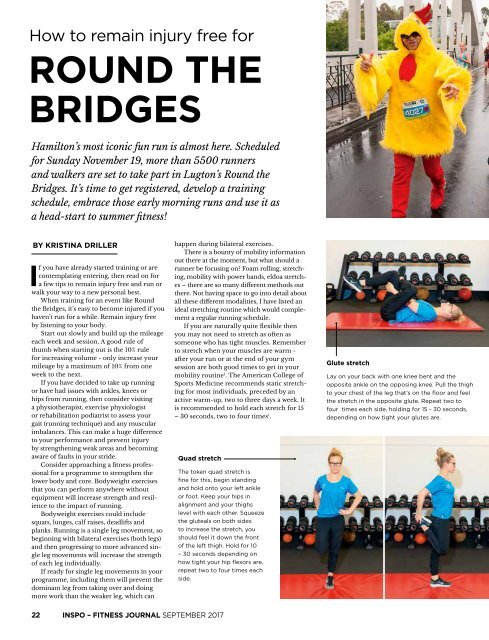INSPO Fitness Journal September 2017
Everything from nutrition, beauty, home and workplace wellbeing to health, performance – and so much more.
Everything from nutrition, beauty, home and workplace wellbeing to health, performance – and so much more.
You also want an ePaper? Increase the reach of your titles
YUMPU automatically turns print PDFs into web optimized ePapers that Google loves.
How to remain injury free for<br />
ROUND THE<br />
BRIDGES<br />
Hamilton’s most iconic fun run is almost here. Scheduled<br />
for Sunday November 19, more than 5500 runners<br />
and walkers are set to take part in Lugton’s Round the<br />
Bridges. It’s time to get registered, develop a training<br />
schedule, embrace those early morning runs and use it as<br />
a head-start to summer fitness!<br />
BY KRISTINA DRILLER<br />
If you have already started training or are<br />
contemplating entering, then read on for<br />
a few tips to remain injury free and run or<br />
walk your way to a new personal best.<br />
When training for an event like Round<br />
the Bridges, it’s easy to become injured if you<br />
haven’t run for a while. Remain injury free<br />
by listening to your body.<br />
Start out slowly and build up the mileage<br />
each week and session. A good rule of<br />
thumb when starting out is the 10% rule<br />
for increasing volume - only increase your<br />
mileage by a maximum of 10% from one<br />
week to the next.<br />
If you have decided to take up running<br />
or have had issues with ankles, knees or<br />
hips from running, then consider visiting<br />
a physiotherapist, exercise physiologist<br />
or rehabilitation podiatrist to assess your<br />
gait (running technique) and any muscular<br />
imbalances. This can make a huge difference<br />
to your performance and prevent injury<br />
by strengthening weak areas and becoming<br />
aware of faults in your stride.<br />
Consider approaching a fitness professional<br />
for a programme to strengthen the<br />
lower body and core. Bodyweight exercises<br />
that you can perform anywhere without<br />
equipment will increase strength and resilience<br />
to the impact of running.<br />
Bodyweight exercises could include<br />
squats, lunges, calf raises, deadlifts and<br />
planks. Running is a single leg movement, so<br />
beginning with bilateral exercises (both legs)<br />
and then progressing to more advanced single<br />
leg movements will increase the strength<br />
of each leg individually.<br />
If ready for single leg movements in your<br />
programme, including them will prevent the<br />
dominant leg from taking over and doing<br />
more work than the weaker leg, which can<br />
happen during bilateral exercises.<br />
There is a bounty of mobility information<br />
out there at the moment, but what should a<br />
runner be focusing on? Foam rolling, stretching,<br />
mobility with power bands, eldoa stretches<br />
– there are so many different methods out<br />
there. Not having space to go into detail about<br />
all these different modalities, I have listed an<br />
ideal stretching routine which would complement<br />
a regular running schedule.<br />
If you are naturally quite flexible then<br />
you may not need to stretch as often as<br />
someone who has tight muscles. Remember<br />
to stretch when your muscles are warm -<br />
after your run or at the end of your gym<br />
session are both good times to get in your<br />
mobility routine 1 . The American College of<br />
Sports Medicine recommends static stretching<br />
for most individuals, preceded by an<br />
active warm-up, two to three days a week. It<br />
is recommended to hold each stretch for 15<br />
– 30 seconds, two to four times 1 .<br />
Quad stretch<br />
The token quad stretch is<br />
fine for this, begin standing<br />
and hold onto your left ankle<br />
or foot. Keep your hips in<br />
alignment and your thighs<br />
level with each other. Squeeze<br />
the gluteals on both sides<br />
to increase the stretch, you<br />
should feel it down the front<br />
of the left thigh. Hold for 10<br />
– 30 seconds depending on<br />
how tight your hip flexors are,<br />
repeat two to four times each<br />
side.<br />
Glute stretch<br />
Lay on your back with one knee bent and the<br />
opposite ankle on the opposing knee. Pull the thigh<br />
to your chest of the leg that’s on the floor and feel<br />
the stretch in the opposite glute. Repeat two to<br />
four times each side, holding for 15 - 30 seconds,<br />
depending on how tight your glutes are.<br />
22 <strong>INSPO</strong> – FITNESS JOURNAL SEPTEMBER <strong>2017</strong>


















